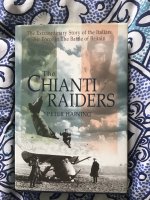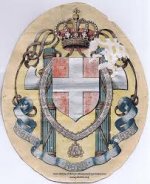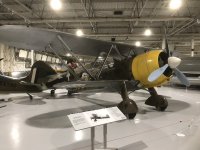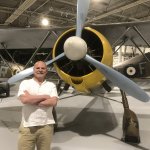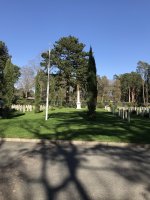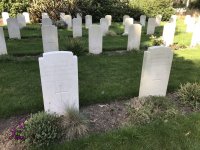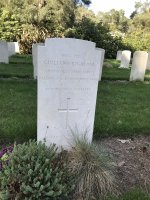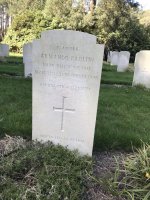1089maul
Member
Let me say from the outset that I really liked this book. It was easy to read and had an easy flow. The Regia Aeronautica‘s (RA) participation in the Battle of Britain normally only gets a small mention in books that study this conflict and sometimes with a little derision. Apart from Lictorian Fasces over England (Subject of a previous review) I know of no other book written in English that deals with the RA’s participation in the battle.
The book consists of 221 pages split into 12 chapters and starts with the shooting down of a Fiat BR20M bomber which had to force land in Rendlesham Forest, Suffolk. Two of the crew died, these as far as I know were the only Italian servicemen to die in combat over England. There followed the discovery in the wreck of the bomber bottles of Chianti and cheese. Thus the Corpo Aero Italiano (CAI) became known as the Chianti Raiders.
The book deals with the reasons why the CAI was created, their formation and subsequent deployment to Belgium followed by detailed accounts of various raids. If a book were to deal with just the raids then it would not be a very long book. The author goes into great detail as to why targets were selected including their history. He also gives mini biographies of both the Royal Air Force (RAF) and RA pilots.
What I particularly liked about the book was the various accounts of pilots from both side and accounts from civilian eyewitnesses. The author has also researched the local police and newspapers for material. The book also deals with the fate of the RA pilots who were captured.
Whilst no RAF aircraft were shot down by the CAI, the author does touch on the subject of CAI claims and damage inflicted on RAF aircraft. Again, this sort of information is never mentioned in other publications which normally vilify Italian efforts.
There are thirty one photographs which are adequate for a book of this nature.
Due to the authors extensive research, there are four pages of bibliography and acknowledgements. Once again, the only criticism I can make is of the one solitary map which is okay but could be enhanced and improved to demonstrate the difficulty that the CAI had in flying inadequate planes to their targets.
To sum up, if you wish to improve your knowledge of the RA’s participation in the Battle of Britain, then this is must book. It is well written and gives a balanced account for both sides.
After reading the book when I first acquired, I made it a mission to visit Brookwood Cemetery to visit the graves of Sergente Giuliano Ripolini and Aviere Mario Paolini who were part of the crew in the above mention BR20M and who died. My visit to the Italian cemetery at Brookwood was subject of a post in the previous Comando Supremo Forum which has since been lost. Unfortunately, I no longer have the photographs so having now reread the book it will be my intention to visit the cemetery again and take new photos to put on this forum. In the meantime I attach photos of Sergente Pietro Salvadori’s Fiat Cr42 which force landed during the battle and which now resides at the RAF museum in Hendon. I also attach a photo of the tail insignia from the BR20M bomber which was cut out by Squadron Leader Tuck and is now displayed in a local museum.
Regards to all,
Bob
The book consists of 221 pages split into 12 chapters and starts with the shooting down of a Fiat BR20M bomber which had to force land in Rendlesham Forest, Suffolk. Two of the crew died, these as far as I know were the only Italian servicemen to die in combat over England. There followed the discovery in the wreck of the bomber bottles of Chianti and cheese. Thus the Corpo Aero Italiano (CAI) became known as the Chianti Raiders.
The book deals with the reasons why the CAI was created, their formation and subsequent deployment to Belgium followed by detailed accounts of various raids. If a book were to deal with just the raids then it would not be a very long book. The author goes into great detail as to why targets were selected including their history. He also gives mini biographies of both the Royal Air Force (RAF) and RA pilots.
What I particularly liked about the book was the various accounts of pilots from both side and accounts from civilian eyewitnesses. The author has also researched the local police and newspapers for material. The book also deals with the fate of the RA pilots who were captured.
Whilst no RAF aircraft were shot down by the CAI, the author does touch on the subject of CAI claims and damage inflicted on RAF aircraft. Again, this sort of information is never mentioned in other publications which normally vilify Italian efforts.
There are thirty one photographs which are adequate for a book of this nature.
Due to the authors extensive research, there are four pages of bibliography and acknowledgements. Once again, the only criticism I can make is of the one solitary map which is okay but could be enhanced and improved to demonstrate the difficulty that the CAI had in flying inadequate planes to their targets.
To sum up, if you wish to improve your knowledge of the RA’s participation in the Battle of Britain, then this is must book. It is well written and gives a balanced account for both sides.
After reading the book when I first acquired, I made it a mission to visit Brookwood Cemetery to visit the graves of Sergente Giuliano Ripolini and Aviere Mario Paolini who were part of the crew in the above mention BR20M and who died. My visit to the Italian cemetery at Brookwood was subject of a post in the previous Comando Supremo Forum which has since been lost. Unfortunately, I no longer have the photographs so having now reread the book it will be my intention to visit the cemetery again and take new photos to put on this forum. In the meantime I attach photos of Sergente Pietro Salvadori’s Fiat Cr42 which force landed during the battle and which now resides at the RAF museum in Hendon. I also attach a photo of the tail insignia from the BR20M bomber which was cut out by Squadron Leader Tuck and is now displayed in a local museum.
Regards to all,
Bob

